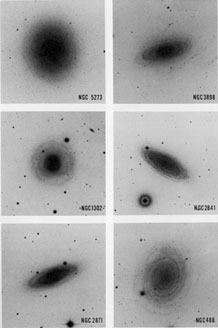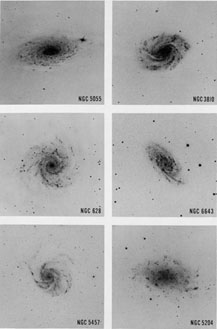


5.2 Spirals With Thin Filamentary Arms
Such galaxies are shown in Plates 2 and 3, arranged in order of increasingly later forms. The 12 illustrated galaxies form a continuously connected sequence. Along this sequence the size of the amorphous central region relative to the disk-length (see Freeman 1970; Sandage, Freeman, and Stokes 1970) generally decreases (there are exceptions) as the arms become more dominant and as the arms and disk become more highly resolved into knots and stars. For the first three galaxies illustrated (NGC 5273, NGC 1302, and NGC 2811) this spheroidal component, including the unresolved arms, covers a large fraction of the total area. However, by the time NGC 6643 [SA(rs)c] is reached along the sequence (Plate 3) the spheroidal component has shrunk to an exceedingly small region, and by NGC 5204 [SA (s)m] has disappeared entirely. The arms are filamentary, and are generally segmented throughout the sequence. Galaxies in this characteristic subgroup are discussed more thoroughly in the Hubble Atlas (cf. section on Sb and the legend to NGC 5055 in Atlas, p. 15).

|
PLATE 2. This and the following plate 3 illustrate the progressive change of appearance along the sequence of classification for thin, multiple-armed ordinary spirals from the earliest type S02/Sa(s) in the upper left (NGC 5273, Atlas, p. 8) to the latest Sm (or Sc/Irr Hubble) at the lower right of plate 3 for NGC 5204. The pictures are arranged in order of increasingly later type by following the left column from top to bottom, and then the right column similarly, in this and the following plate. The types of the galaxies can be found in table 2 of the text. Photographs taken with Mount Wilson or Palomar reflectors as described in the Hubble Atlas (Sandage 1961). |

|
Plate 3. Continues the sequence of thin, multiple-armed ordinary spirals from plate 2 into the middle Sb to late Sd-Sm sections. The gradual and progressive changes of arm structure from Sa to late Sc form the continuous pattern visible in this sequence. The continuity is described in the Hubble Atlas in the text of the Sb section (Atlas, p. 16), and in the commentary to pictures on pp. 14 and 15 of the Atlas section (see in particular the description of NGC 5055). Mount Wilson-Palomar photographs. |